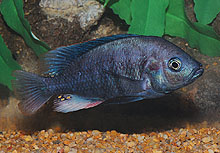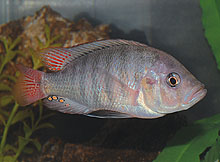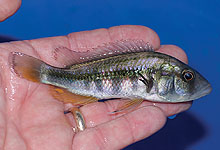WHAT'S NEW ACROSS THE WORLD
Select date in side bar to go to a What's New of previous issues
| What's New
©by Laif DeMason
Had enough of winter? I have! It is good to see that Spring is finally on the way. In case you have missed it, there has been some new African cichlid collecting in areas not typically harvested. We have seen several wild caught species arrive which haven’t been available for some time. Both the northern Congo coast of Lake Tanganyika and the Mwanza area of Lake Victoria have recently been visited. This is good news for breeders who want to invigorate their strains with wild bloodlines.
Here’s “what’s new” on the cichlid scene: |
Lake Tanganyika
The northern Congo coast is now becoming more available for cichlid collecting since its heyday in the early 1990s. There has generally been sporadic collecting over the years since then, from Tanzanian dive teams, and of course the more serious harvesting of wild fish like Neolamprologus leleupi and Julidochromis ornatus about five years ago. It would appear the northern Congo coast’s door is now opened. Tanzanian dive teams are also looking more carefully in previously ignored nooks for new varieties with some success.
|
WHAT'S NEW: LAKE TANGANYIKA
|
 One of the recently exported species that has never really been sold regularly is the Ophthalmotilapia ventralis from northern Congo. Pictured here is this O. ventralis from the Ubwari Peninsula showing its typical blue coloration with a black streak in its mid-flank. Photo by A. Konings.
One of the recently exported species that has never really been sold regularly is the Ophthalmotilapia ventralis from northern Congo. Pictured here is this O. ventralis from the Ubwari Peninsula showing its typical blue coloration with a black streak in its mid-flank. Photo by A. Konings.
|
 Previously exported in the 1990’s, Petrochromis polydon red fin texas from the Ubwari Peninsula, Congo has arrived again. This fish was sold in the past as Petrochromis sp. ‘red fin texas’, for its obvious bright red fins and its “Texas cichlid” facial striations.
Previously exported in the 1990’s, Petrochromis polydon red fin texas from the Ubwari Peninsula, Congo has arrived again. This fish was sold in the past as Petrochromis sp. ‘red fin texas’, for its obvious bright red fins and its “Texas cichlid” facial striations.
|
 Also exported years ago fairly regularly from Tanzania but not again for over a decade, Tropheus Dahabu sporting its yellow cheek markings. Related to the red cheeked Tropheus from Mpimbwe, this yellow cheeked variety never gains the red cheek markings that its more famous cousin does.
Also exported years ago fairly regularly from Tanzania but not again for over a decade, Tropheus Dahabu sporting its yellow cheek markings. Related to the red cheeked Tropheus from Mpimbwe, this yellow cheeked variety never gains the red cheek markings that its more famous cousin does.
|
 South of Wapembwe, this new color variety of Tropheus moorii is from Isinga, Tanzania (not Isanga, Zambia!). The newly exported Tropheus has a bluish dorsal fin with overall yellow rainbow body markings, along with a mid-body yellow botch at times.
South of Wapembwe, this new color variety of Tropheus moorii is from Isinga, Tanzania (not Isanga, Zambia!). The newly exported Tropheus has a bluish dorsal fin with overall yellow rainbow body markings, along with a mid-body yellow botch at times.
|
Lake Victoria
Exciting news for Victorian cichlid fans, the Mwanza, Tanzania area was recently collected, not once, but twice! A new load of not often seen cichlids from that area along with the (of course) not yet known species have been sent to France and the USA. Unfortunately the water clarity and catching conditions, not to mention the export logistics and costs, are so difficult, this may be the last effort for a while. Enjoy while you can.
|
WHAT'S NEW: LAKE VICTORIA
|

Caught around Juma Island this Pundamilia nyererei was exported at a somewhat smaller size than other P. nyererei from that area. Its markings and color is very similar to other P. nyererei in the Mwanza Gulf region, although the red coloration on its dorsum seems to be a bit darker ruby red.
|

This Neochromis species is from Makobe Island, Tanzania. This fish is similar to other so-called ‘blue scraper’ species, but seems to have a longer body and a nice sky blue color. Hence the fish was sold as Neochromis ‘long scraper’, but could be N. omnicaeruleus. Its quiescent black dorsal fin turns blue under good conditions.
|

Another new arrival from Juma Island, Tanzania, is, at best guess, a ‘rock-picker’ type from the genus Mbipi. It is sold as Mbipi ‘barred blue dorsal rock picker’ for lack of a better handle. The quiescent vertical bars are replaced with blue and green body hues, a yellow chest/abdominal region, and red marks on its cheek and pectoral area.
|

From Makobe Island, Tanzania is yet another new import with interesting features. It is characterized by an upturned mouth and a deep body often seen in Pundamilia species. Its overall color is rich black with very little red fin trim found mainly in the anal fin which is half white and half red. For now it is sold as P. ‘red anal nyererei’.
|

From Juma Island, Tanzania, comes a Pundamilia very similar to a cichlid from Uganda called ‘Haplochromis’ Pink Flush (circa 1990). It is also similar to the ‘zebra nyererei’ or P. pundamilia but without the classic steel gray body color, as this fish seems to have a pinkish cast. It was shipped as P. ‘seven stripe’ due to the distinct vertical bars.
|

Perhaps a new predator species, this cichlid was part of the latest shipment from the Mwanza, Tanzania area. This fish could belong to Harpagochromis, but its true identity is unknown. Individuals received had two distinct horizontal black stripes along with yellow anal and caudal fins.
|
Select date in side bar to go a What's New of previous issues |
 One of the recently exported species that has never really been sold regularly is the Ophthalmotilapia ventralis from northern Congo. Pictured here is this O. ventralis from the Ubwari Peninsula showing its typical blue coloration with a black streak in its mid-flank. Photo by A. Konings.
One of the recently exported species that has never really been sold regularly is the Ophthalmotilapia ventralis from northern Congo. Pictured here is this O. ventralis from the Ubwari Peninsula showing its typical blue coloration with a black streak in its mid-flank. Photo by A. Konings.
 Previously exported in the 1990’s, Petrochromis polydon red fin texas from the Ubwari Peninsula, Congo has arrived again. This fish was sold in the past as Petrochromis sp. ‘red fin texas’, for its obvious bright red fins and its “Texas cichlid” facial striations.
Previously exported in the 1990’s, Petrochromis polydon red fin texas from the Ubwari Peninsula, Congo has arrived again. This fish was sold in the past as Petrochromis sp. ‘red fin texas’, for its obvious bright red fins and its “Texas cichlid” facial striations.
 Also exported years ago fairly regularly from Tanzania but not again for over a decade, Tropheus Dahabu sporting its yellow cheek markings. Related to the red cheeked Tropheus from Mpimbwe, this yellow cheeked variety never gains the red cheek markings that its more famous cousin does.
Also exported years ago fairly regularly from Tanzania but not again for over a decade, Tropheus Dahabu sporting its yellow cheek markings. Related to the red cheeked Tropheus from Mpimbwe, this yellow cheeked variety never gains the red cheek markings that its more famous cousin does.
 South of Wapembwe, this new color variety of Tropheus moorii is from Isinga, Tanzania (not Isanga, Zambia!). The newly exported Tropheus has a bluish dorsal fin with overall yellow rainbow body markings, along with a mid-body yellow botch at times.
South of Wapembwe, this new color variety of Tropheus moorii is from Isinga, Tanzania (not Isanga, Zambia!). The newly exported Tropheus has a bluish dorsal fin with overall yellow rainbow body markings, along with a mid-body yellow botch at times.





